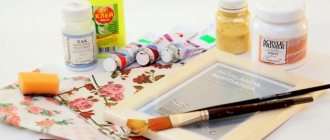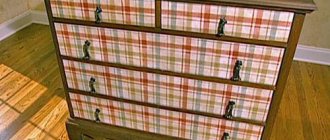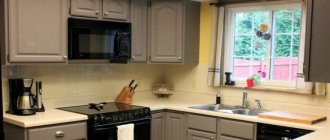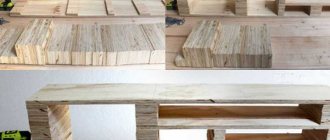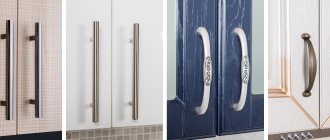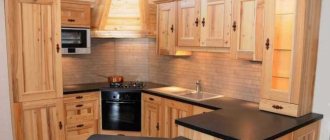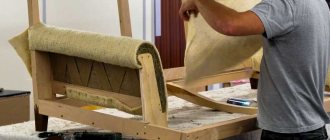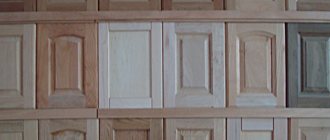Interior details made in handmade style are used to decorate different design trends, giving them comfort and individuality.
Do-it-yourself kitchen decoupage involves not only decorating a boring set, table and chairs, but also the ability to restore them to an attractive appearance in case of damage to the coating or loss of color.
Decoupage as a kitchen restoration
The kitchen is characterized by high humidity and constant temperature changes. All this affects the surface of the furniture. Small mechanical damage can also be a reason that prompts restoration of the kitchen set. There are simply many reasons for this:
- After many years of use, any furniture needs changes, especially its appearance.
- Minor furniture repairs may be needed after a flood caused by your neighbor on the floor above.
- Having repaired the walls and floor in the kitchen, you can use decoupage to update the furniture.
- By changing the configuration of kitchen furniture and using decoupage technology, you can completely change the interior of the kitchen.
- Decoupage will help remove minor scratches on the surface of furniture.
There are a lot of reasons to use decoupage to revive a kitchen set.
There is no finance for a full-scale renovation, you can decorate the interior and everything will sparkle with different colors. A wooden stool can be decorated with a beautiful image and varnished. Decoupage will allow you to change the facades of hanging cabinets and the set itself.
Designers' suggestion: in order not to use the same pattern throughout the kitchen, you can choose several similar plot pictures that will smoothly transition into one another. This kind of work requires a lot of effort, but the result is worth it.
What is decoupage
Decoupage is a decorative method . It involves gluing cutouts from a variety of available materials (paper, fabric, napkin, etc.) onto the surface of various objects and applying varnish for effect.
Decoupage of old furniture literally transforms it. The kitchen changes a lot and becomes very sophisticated and interesting . This decoration technique is within the power of any person and allows you to create exclusive interior items at virtually no cost.
Doing decoupage on furniture with your own hands requires diligence and patience . However, the result will exceed all expectations.
Suitcase of tools for kitchen decoupage
Many of the necessary tools for kitchen decoupage are purchased depending on the material used to make the furniture. But there is also a standard set:
- To repair small cracks, a vapor filler is required.
- The surface of the headset is cleaned with fine sandpaper.
- Purchase special glue for decoupage. It is used when working with thick paper. An alternative could be PVA glue, but its use is possible if it is applied to the surface of a napkin.
- The hardness of the brush should be medium to work.
- The obligatory presence of acrylic varnish, which is used to cover wood, possibly plastic. It all depends on the material of the headset.
- Small scissors are more convenient to work with.
- Extracts from magazines, photos taken on a printer, special napkins, photo wallpapers, self-adhesive film can be used as images for decoupage.
- A common tool that will help you cope with twisting loose furniture.
It is better to start your first experiments on a smooth, level surface. For example, chairs and stools are suitable.
Master Class
Let's consider the process of decoupage of a kitchen set step by step:
- Before gluing, the undamaged surface is washed and degreased. If the facade is being restored, the furniture is sanded, removing the old coating. Large cracks are sealed with putty. If necessary, paint with acrylic compounds.
- The prepared elements are covered with glue, placed in the place of fastening and smoothed with a painting brush with soft bristles. If you plan to cover the entire facade, first apply glue to its surface and allow it to set.
- After the glue has dried, decoupage effects are applied: aging or gilding.
- The final stage is coating with acrylic transparent varnish in several layers at intervals of 2 hours.
Decoupage taking into account the style of the kitchen
Kitchen design largely depends on your desires. But designers advise adhering to some nuances in order to maintain the interior style:
- Images of butterflies, various cats, an abundance of vegetables and fruits, bouquets of wild flowers, rustic motifs in various forms, intertwining patterns - all this is possible in ethno, country and Provence styles.
- Garden flowers, richly painted drawings, images of grape vines, angels decorate the kitchen in a classic style.
- Newspapers, geometric shapes, images of inscriptions, photos in black and white style, a zebra pattern - suitable for a kitchen in a modern style.
How to decoupage an old cabinet with the effect of staining, aging with craquelure and bitumen
If you want to decoupage a kitchen cabinet in Provence, shabby chic, country or vintage style, then you will need special tools to create the antique effect. Craftswomen have a truly huge selection of them.
- Lucky . The most popular varnish in decoupage for creating artificial cracks is craquelure. Apply in two stages.
- Stains . Wooden surfaces can be additionally stained with stain to highlight the texture of the wood.
- Bitumen. Using bitumen and wax on the surface of a cabinet door with decoupage, you can create an aging effect.
- Waxes . They are used to patina facades and give an interesting shade to surfaces.
Additional materials at hand:
- Gloves and respirator . Most formulations are quite aggressive to the skin of the hands and have a strong odor. You will also need to use white spirit to clean your brushes.
- Sponges and rags . Disposable sponges are an excellent replacement for brushes - and you can throw them away immediately after use, without wasting time on washing. A soft rag is useful for wiping surfaces, oiling, etc.
Watch a master class on how to decoupage a cabinet with your own hands using one of the listed techniques.
The “patina of antiquity” looks impressive on wardrobes with decoupage and craquelure. The area of surface preparation followed by treatment with craquelure varnish is much larger. Therefore, try to implement your plan first on a small area of material to understand how best to work with it.
"Delicious cuisine
You can use coffee-scented kitchen design technology:
- Lightly moisten clean sheets of paper.
- Instant coffee is sprinkled over them.
- Lightly press the coffee into small grains with your hand and rub it onto the sheets.
- In this state, leave the sheets to dry.
- After complete drying, they can be glued to furniture. The kitchen will smell like coffee.
Execution technique
Decoupage has firmly established itself in the field of modern interior design. Handmade masters have developed a standard algorithm that will allow beginners to avoid serious mistakes.
The work is structured as follows:
- choose a product or surface to decorate;
- select the most suitable material for this;
- prepare a well-lit work space;
- check whether the chosen restoration style matches the interior;
- prepare decorative elements (cut out, print, try on products);
- decoupage of a kitchen box begins with sanding the surface with sandpaper;
- Next, you need to fill all existing cracks with a special product;
- if the wood has dried out, use putty;
- after cleaning, the module is carefully treated with a primer;
- glue is applied to the surface of the product in the place where the design will be located;
- the material is also thoroughly impregnated with glue;
- each cut out element is placed in its place according to the overall picture;
- if small bubbles have formed, they are punctured;
- Then the material is carefully smoothed with a roller or brush.
In this condition, it is important to allow time for the product to dry completely. Sometimes this takes from 3 to 12 hours. Finally, the surface is varnished (it is necessary to apply 3-4 layers at intervals of an hour). The kitchen is a place with aggressive conditions, and varnish can protect furniture from exposure to steam, grease, detergents and high temperatures.
Decoupage any surface in the kitchen
Of course, a set embellished with decoupage techniques greatly changes the atmosphere. But you can also decorate other surfaces in the room.
Decoupage floor
The wooden floor must be sanded and all uneven surfaces removed. Today, one of the stylish techniques is to create an imitation rug using fabric. Of course, everything needs to be covered with 2 layers of high-strength varnish. Otherwise, all the work will be done in vain.
Decoupage walls
The walls with photographs and pictures randomly placed on them are transformed in an interesting way.
Ceiling decoupage
This is where you can show a full flight of fantasy. Images and clippings from magazines are suitable here; various patterns can be assembled into a composition.
Zoning
In the kitchen-living room, using the decoupage technique, you can easily highlight a certain corner in the room.
Decoupage apron
A beautifully designed apron will simply decorate the kitchen work area and will immediately catch your eye. The drawing is not too small. The choice should be made based on the area of decoration.
Furniture made using decoupage technique
Furniture is the most noticeable part of the interior and it is it, decorated using the decoupage technique, that will truly decorate the kitchen space. This is especially appropriate if your furniture is already old and uninteresting - this will breathe new, colorful life into it.
In the photo of kitchen decoupage, you can find stunning examples with different designs, choose the most suitable ones, or use the examples to come up with your own.
Decoupage of household items
In the kitchen, it is small household items that create an atmosphere of comfort. If you decorate them, they will help emphasize the atmosphere in the kitchen. Decoupage of small items can be entrusted to children if they are interested in the work. You can decorate a cutting board, salt shaker, decanter. To transform these parts you need to purchase a non-toxic varnish. It is better to decorate a set of some items with pictures of one composition. Duplicating one design on all objects, for example a set of jars, will not look so bright. Decoupage can be done on almost any item in the kitchen.
The availability of materials for decoupage will allow you to quickly and economically transform your kitchen. Creative work will bring you satisfaction when your kitchen becomes a small masterpiece. Decoupage also helps to breathe new life into many old things.
https://youtu.be/a_fwD6UADU8https://youtu.be/tCklgnaY0WU
_
DIY cabinet decoupage with wallpaper and fabrics
Sometimes decoupage means completely covering an old cabinet with wallpaper or fabric. Or some part of it. For example, the back walls of open shelving cabinets - this technique looks very fresh and original, allowing the furniture to fit more organically into the interior and make it more elegant.
Facades and sidewalls are also pasted over – at will and according to the author’s idea.
DIY cabinet decoupage with wallpaper, photo from curbalertblog.com
The process of covering a closet with wallpaper, newspapers or fabrics is not much different from decoupage with cut out “appliqués”. The only thing is that the material used is not a cutting of some motif, but a piece of fabric or wallpaper of the required size to completely cover the selected surface.
Step 1. Priming, photo girlinthegarage.net
Step 2. Painting, photo girlinthegarage.net
Step 3. Decoupage of cabinet doors and drawers, photo photo girlinthegarage.net
DIY cabinet decoupage step by step master class for beginners
When decoupaging a closet or chest of drawers with fabric, wallpaper, newspapers, or cards, you can use the so-called “decopatch” patchwork technique. In this case, the material is cut into pieces and glued overlapping each other, imitating brickwork or mosaic. After drying, the boundaries of the overlap are sanded off a little, preserving the resulting “relief” of thickenings. Then coated with finishing varnish.
Accessories decor
Expert advice:
- Decorating small kitchen items gives the kitchen an incomparable aesthetic meaning. In addition, decorating small objects does not require special skills and knowledge, and even schoolchildren can do it.
- Utensils intended for cooking and exposed to high temperatures (pots, frying pans, etc.) should not be decorated, since no varnish coatings will withstand high heat.
- Tableware and cutlery require careful and careful selection of coating components. They must not contain toxic substances.
- Repeating identical images on decorated objects is less attractive than different designs connected by the same theme.
- Even small cutlery can be decorated. However, such work will require significant labor and can only be successfully completed by patient and careful craftsmen.
- Decorated cutlery that is no longer in use can be used as pendants.
Decoupage is a simple decoration technique accessible to most home craftsmen. With its help you can decorate most household items and improve the interior design of your apartment.
https://youtu.be/AZ3Vmwwggt8https://youtu.be/dhALiMOkQE4
_


